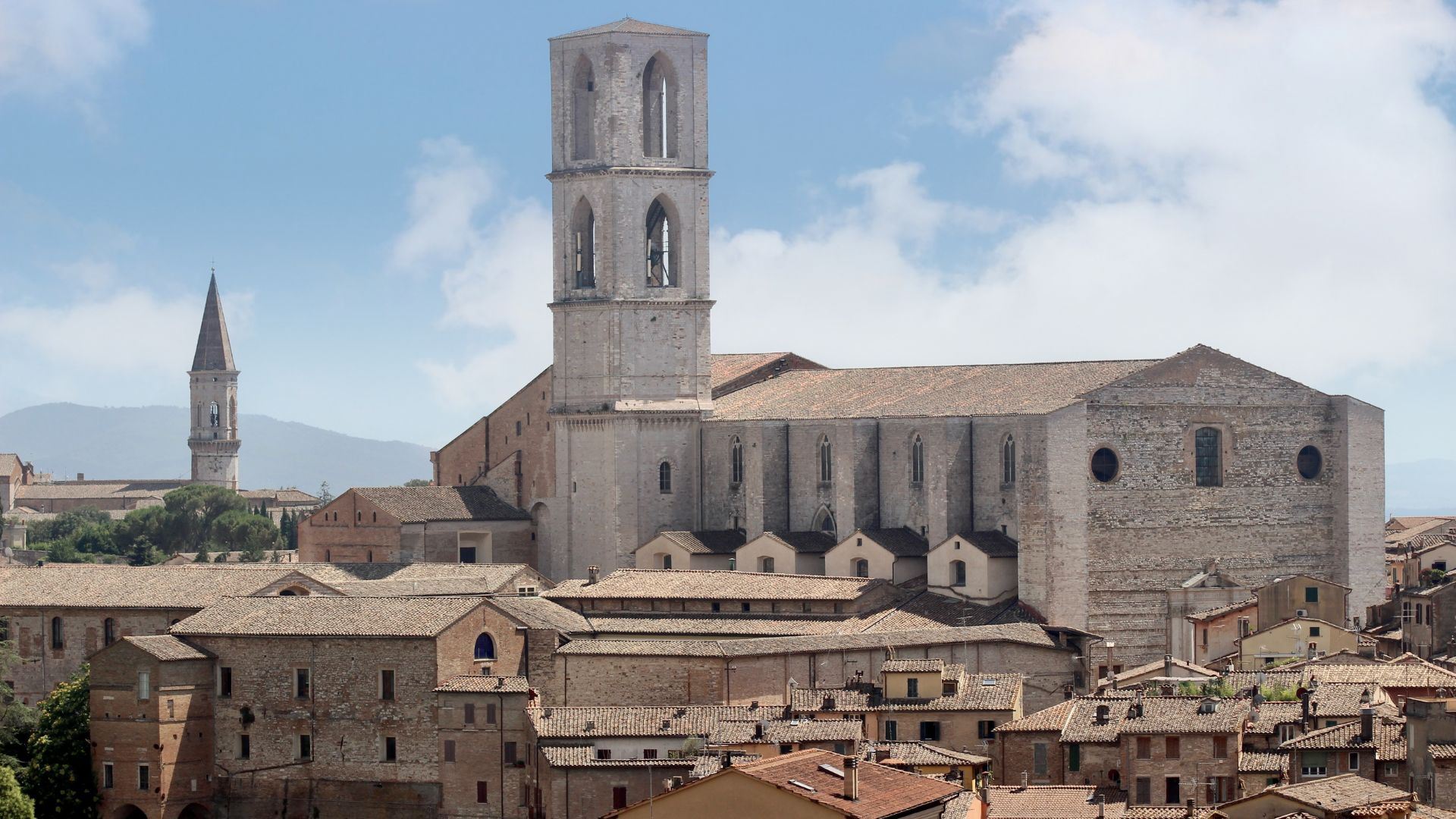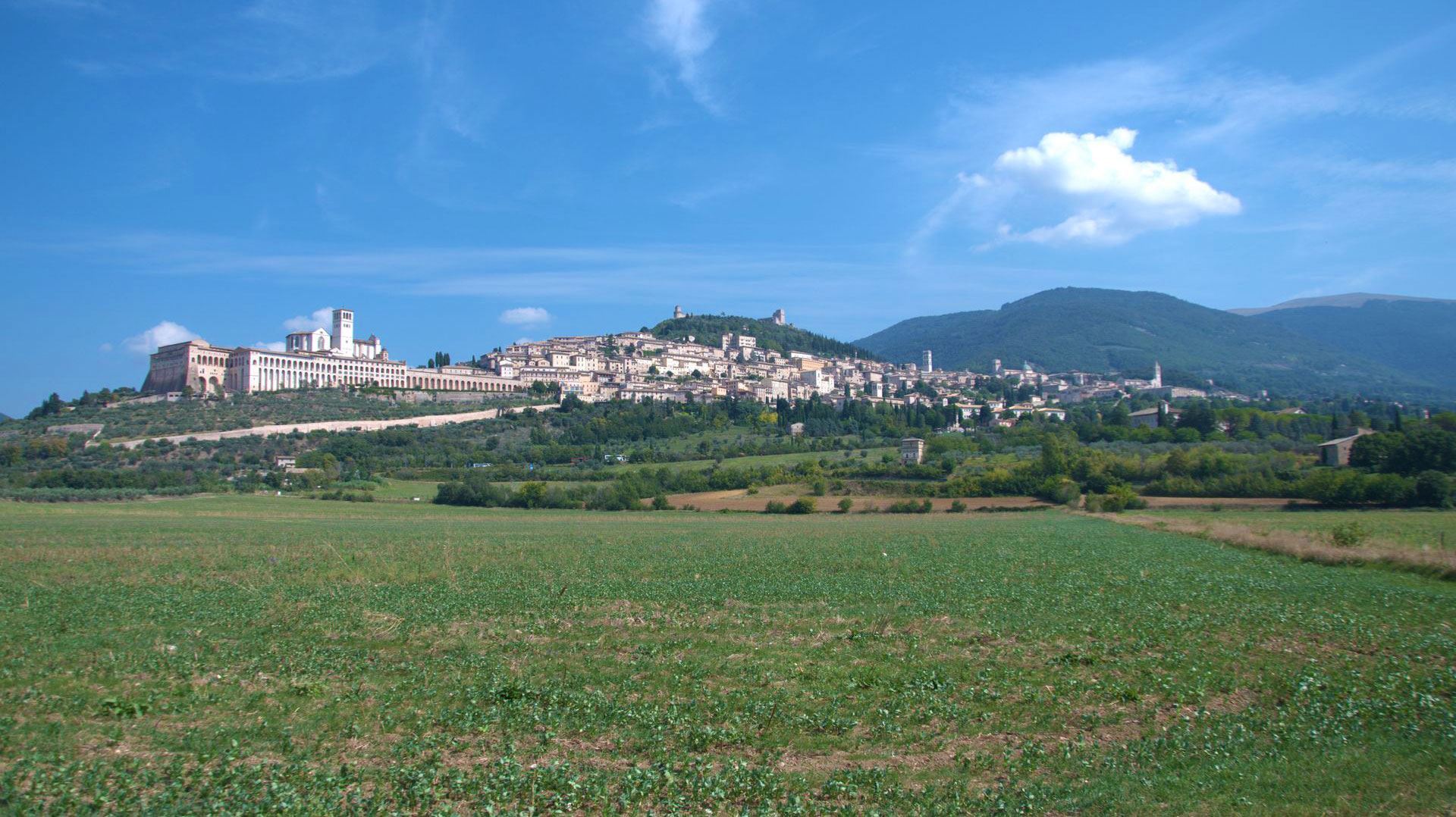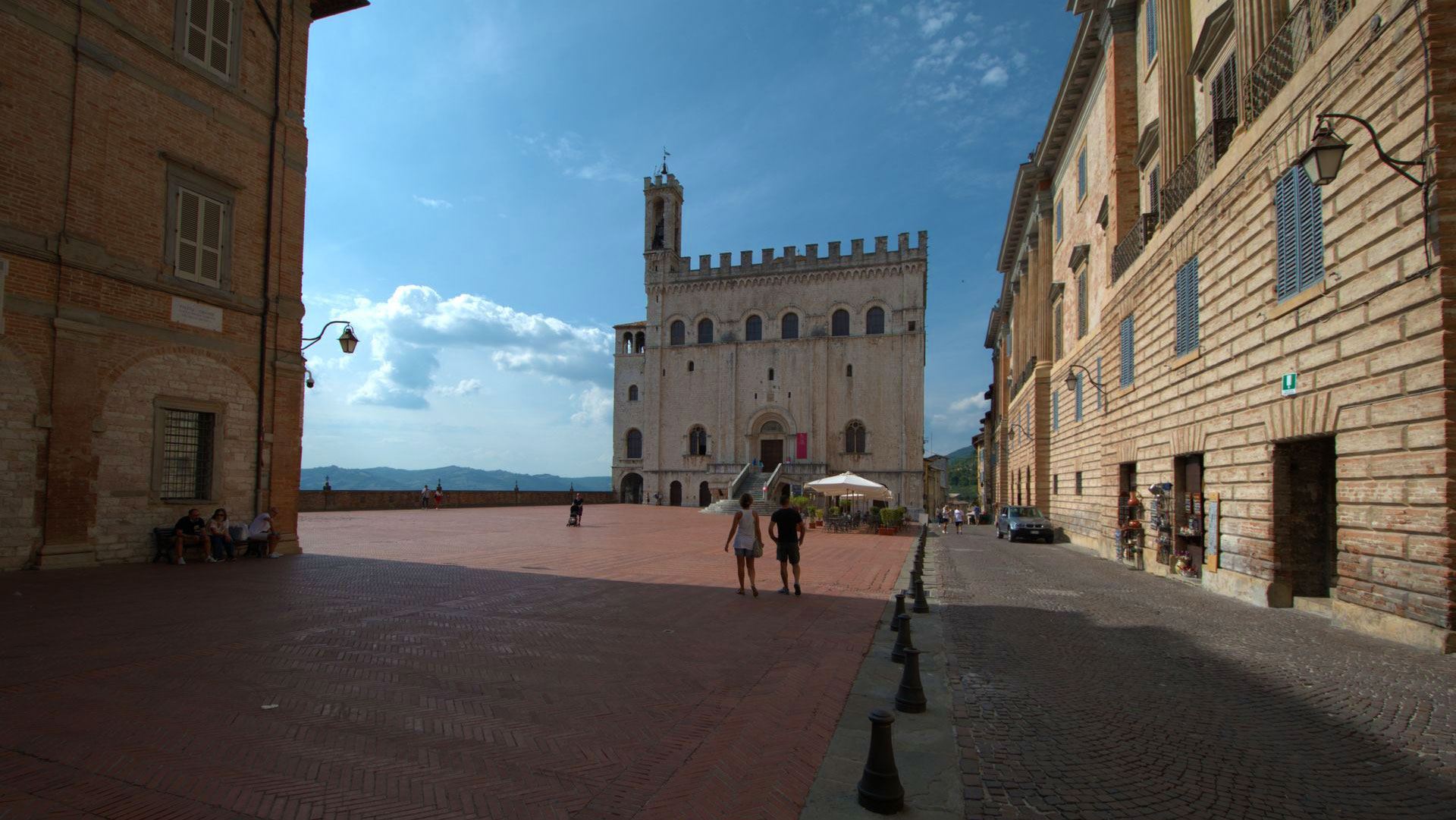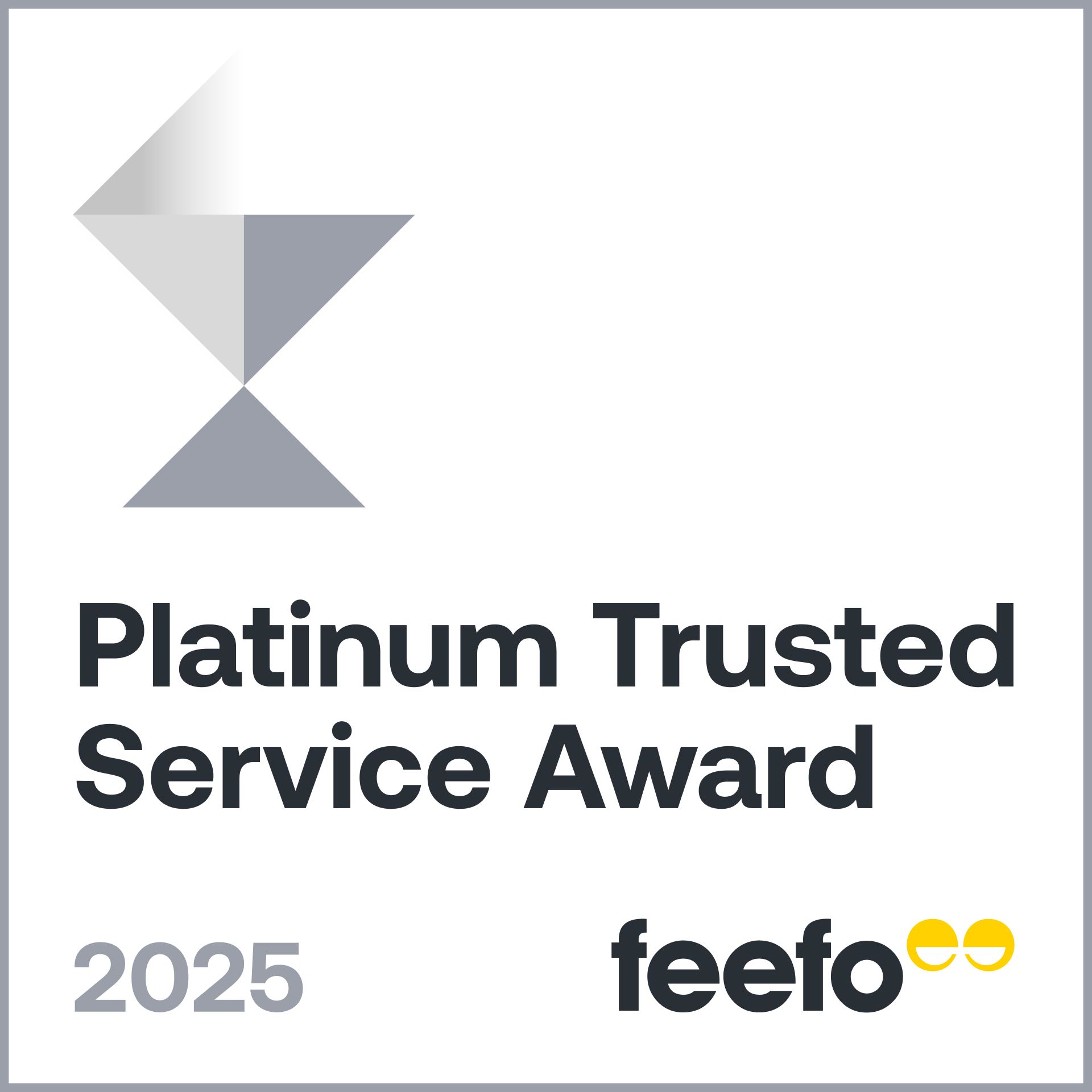The hazy hills, a magical quality of light, and an air of spirituality help set Umbria apart, along with its bewitching capital, Perugia. Cosmopolitan, arty, heritage-minded yet forward-looking, Perugia makes a delightful introduction to the region, with easy side trips to Assisi, Gubbio and Lake Trasimeno. Compared with Florence, Perugia feels far less tourism-led.
Umbria has often languished in Tuscan’s shadow but is just as lovely as its grander neighbour. Lap up the rolling landscape with hill-towns that look as if they have been there since time immemorial. It is not an illusion: some were founded by the Etruscans and later dedicated to medieval saints. Even if Perugia feels more secular than most of the region, Umbria is the cradle of western monasticism, with St Benedict born in Norcia. Beyond the tourism hotspot of Assisi, the region strikes a near-perfect balance between sustainable tourism and an authentic way of life.
Why not travel to Tuscany and see why we love it so much! Find your perfect Tuscan villa today and browse our collection near Perugia.
Contact our Villa Specialist, who can help you find the ultimate Tuscan villa tailored to you.
Perugia
-
-

Top Ten Things To Do
Perugia is both the capital of Umbria and the perfect gateway to exploring the region. From visiting art galleries and people-watching on medieval squares to munching chocolate “kisses,” Perugia offers great variety. The regional capital also makes a superb springboard to exploring several of Umbria’s loveliest cities. For day trips, our top picks are spiritual Assisi, Lake Trasimeno and Gubbio, a medieval city in miniature – with full highlights covered in our Top Ten guide.
-

1. Piazza IV Novembre - for city life
Henry James called Perugia the “little city of infinite views” and this feels true of Piazza 1V Novembre, Perugia’s theatrical main square. This was where Roman and Etruscan civilisations once came together. Today, it’s a meeting-place made for café life and cocktails, catch ups over ice-creams and street entertainment. Overlooking the square, Caffe del Banco (officially on 5 Corso Vannucci) works at any time of day. Come for coffee, cocktails on for coffee or a local draft beer, Birra Perugia.
The square spouts the splendid Fontana Maggiore, a Romanesque masterpiece created by the Pisan father-and-son team, Nicola and Giovanni Pisano, between 1275 and 1278. This pink-and-white marble fountain displays bold decorative flourishes, from the signs of the zodiac to a griffin, the city symbol. On the far side of the fountain rise the steps to the austere Gothic cathedral, where people and pigeons gather to preen and flirt. Inside, the mystic Deposition, painted by Barocci while under the influence of poison proffered by a rival, inspired the Rubens masterpiece known as The Antwerp Descent. Sweeping down from the piazza is the bustling Corso Vannucci. On the right bristle the Gothic crenellations of the Palazzo dei Priori (Town Hall), one of the grandest public palaces in Italy. Fan-shaped steps lead to the Sala dei Notari, the lawyers’ meeting hall, painted at the end of the 13th century.
Address: Tourism in Perugia: Piazza Matteotti, 18 Loggia dei Lanari, 06100 Perugia
Web: http://turismo.comune.perugia.it/ -
2. Galleria Nazionale dell’Umbria – top art gallery
As Umbria’s foremost art gallery, the Galleria Nazionale dell’Umbria celebrates its centenary in 2018. Flanking Corso Vannucci, the museum occupies a Gothic mansion dating back to the 13th century. Formerly the seat of the local magistracy, the palazzo boasts an ornate portal, mullioned windows
and fortress-like crenellations. Inside is a treasure-house of Umbrian and Central Italian art, displaying Byzantine-inspired 13th-century paintings, Gothic works by Gentile da Fabbriano, as well as Tuscan masterpieces by Piero della Francesca and Fra Angelico. Also on show are masterpieces by hometown heroes, Perugino and Pinturicchio.
Next door is the palace’s 15th-century Collegio del Cambio This medieval money exchange is graced by Perugino’s frescoes, which fuse Classical and Christian themes. Pietro Vannucci (c1450-1523), better known as Perugino, was born near Perugia but found fame in Florence and Rome, where he decorated part of Rome’s Sistine Chapel before returning to his homeland. Raphael, the last true artist of the Renaissance, was born in Umbria in 1483 and was trained in Perugino’s workshop, work¬ing on frescoes in Perugia. He later left for glory in Florence and Rome.
Address: Palazzo dei Priori, Corso Vannucci 19, 06123 Perugia
Web: https://gallerianazionaledellumbria.it/en/ -

3. Corso Vannucci – a people-watching parade
If Perugia is the sun around which the other towns of Umbria orbit, then Corso Vannucci is the proof of its vitality. The Corso is the main thoroughfare and demonstrates how Perugia is a likeable, cultured, walking city. Corso Vannucci, and its early evening passeggiata, can best be appreciated from a café terrace, and includes a parade of relaxed locals and animated foreign students. Bars and cafes abound, including in the side streets just off the Corso. At festival time, especially during Umbria Jazz, the area becomes a cultural hub. Even outside festival time, Corso Vannucci shows that Perugia is a party-loving university city and a pleasure-seeking foodie city.
Strolls along the Corso often end in the Giardini Carducci, set on the site of a demolished fortress. From these gardens are some of the finest views in Perugia, with the hills twinkling under the stars. By day, the views are of the cypress-cloaked hills.
Address: Tourism in Perugia: Piazza Matteotti, 18 Loggia dei Lanari, 06100 Perugia
Web: http://turismo.comune.perugia.it/ -
4. Rocca Paolina – secret Perugia
A mysterious series of tunnels provides an early sense of Perugia’s nooks and crannies. This helter-skelter of cobbled alleys and arched stairways is essentially all that remains of a once imposing fortress. Known as the Rocca Paolina, the stronghold was commissioned by Pope Paolo III Farnese in the 1540s. Its creation led to the destruction of a prosperous neighbourhood. Churches, monasteries and around a hundred houses were razed and recycled to create the fortress. The citizens of Perugia had to wait until 1848 for the first, partial demolition of the hated symbol of Papal power, with its final destruction only achieved in 1860 with the Unification of Italy.
Today, these vaulted foundations form part of a popular route that funnels visitors into town from Piazza Partigiani. Riding the series of escalators (scale mobili) through the walls is a typical urban experience. It feels like gaining entry to a lost world, with secret doorways revealing the odd shop or venue for art exhibitions.
Address: Piazza Matteotti, 18 Loggia dei Lanari, 06100 Perugia
Web: http://turismo.comune.perugia.it/poi/rocca-paolina -
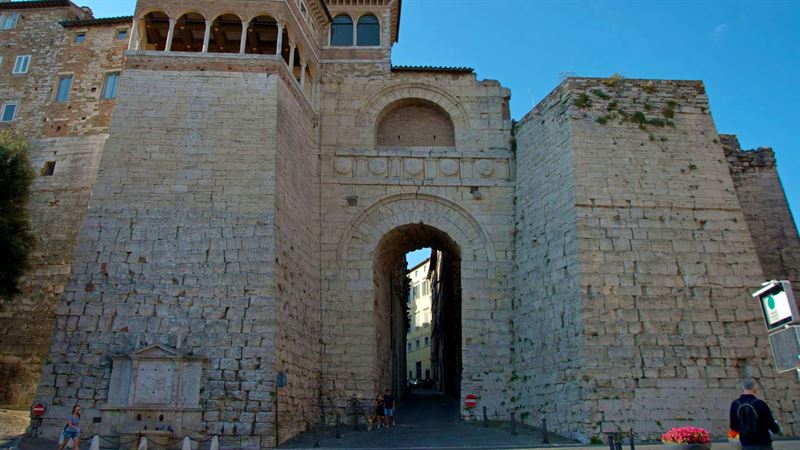
5. Etruscan Perugia
It can be difficult to decipher Etruscan Perugia in such a dense, hilly, multi-layered city. The point is not to track down every Etruscan site but to be aware of everyday Etruscan treasures as you pass them. Stretches of Etruscan walls survive, as do several gateways - and even a well, off bustling Piazza IV Novembre. Best of all is the so-called Etruscan Arch. This northern gateway, the Arco Etrusco, is built into the original city walls and is the most memorable and monumental of Etruscan sites. As the most ancient gateway in town, it dates from the 3rd century BC. It lies at the end of via Ulisse Rocchi, facing Piazza Fortebraccio, and bears a Roman inscription on the upper part: 'Augusta Perusia', stressing the city’s ultimate submission to Rome. If the odd Etruscan sighting has whetted your appetite, then visit Perugia’s Archaeological Museum, set just outside the Etruscan city walls. San Domenico’s cloisters are home to the Museo Archeologico, which displays Etruscan pottery, funerary slabs and metalwork, including a bronze chariot.
-

6. Magical, mystical Assisi
Assisi remains a spiritual place apart, despite the crowds. By car, Assisi is only 30 minutes east of Perugia but lives in its own rarefied world. The approach to Assisi reveals St Francis’ Basilica rise about the perpetual Umbrian haze, with the towering peak Mount Subasio looming beyond. The blissful sense of peace makes our humdrum world feel forgotten. The austere Basilica di San Francesco is perfectly situated for sunsets. Inside, the Upper Basilica is adorned with Giotto’s famous fresco cycle on the Life of St Francis, restored following the 1997 earthquake. Instead, the Lower Basilica reveals a jigsaw puzzle of frescoes, including scenes of uplifting sweetness by Simone Martini, where even the horses seem to smile. As if in reproach, the sternly didactic vault frescoes remind pilgrims of the monastic virtues of Chastity, Poverty and Obedience. The crypt where St Francis is buried is a significant pilgrimage site, attracting sandalled, prostrate pilgrims.
Beyond this spiritual hub, Assisi is almost too picture-perfect. Flower-bedecked balconies give way to secret gardens, with the scent of roses and wood-smoke permeating the air. The forbidding Rocca Maggiore, looming above the town, formed part of a string of towers guarding Assisi. No churches can live upto San Francesco. Even so, the striking Romanesque Duomo reveals a three-tiered façade and sculpted central portal, decorated with lions and griffons. Below the Duomo stands Santa Chiara, dedicated to the founder of the Order of the Poor Clares, the female wing of the Franciscans. The pink-and-white façade boasts buttresses that are decidedly feminine in their generous curves.
For a sense of the solitude and spirituality that suffused the lives of St Francis and St Clare, head to a spiritual retreat on the outskirts of Assisi. Il Bosco di San Francesco, St Francis’ Forest, represents a rural landscape quietly shaped by over 800 years of history. From woodland to olive groves and enchanted glades, this still feels like St Francis’ domain, inviting us to explore our relationship with nature and God. The trails meander around the slopes of Mount Subasio behind the Basilica of Saint Francis. The 64-hectare area of woodland trails is beautifully kept by the FAI, the Italian heritage body, the equivalent of the UK’s National Trust. The visitor centre is housed in a Benedictine monastery, the Convento di Santa Croce. Traditional Umbrian fare, such as truffled pasta, is served on the terrace of the neighbouring Osteria al Mulino, a converted mill.
Address: Tourism in Assisi: Piazza del Comune, 06081 Assisi
St Francis’ Forest, Il Bosco di San Francesco
Web: https://www.fondoambiente.it/bosco-di-san-francesco-eng/ -

7. Gubbio – medieval Umbria in miniature
From Perugia, the road winds northwards to Gubbio, one of the most intact medieval towns in Italy. It’s under an hour’s drive to the so-called `city of silence,’ named for its desolate position in the Umbrian backwoods. Today, Gubbio is easily accessible yet still retains its air of inviolability. The setting is dramatic and often windswept, with the town clinging to the side of Monte Ingino, and its ancient palazzi stacked on steep terraces.
For a lofty view, take the funicular railway to the top of Monte Ingino from the station in via San Geraloma. At the top, St Ubaldo, the city’s protective saint, is worshipped in Basilica di Sant’Ubaldo, with his mummified body set above the altar. The basilica also displays the three huge candles which sturdy citizens carry in a frenzied race up the hill every May 15, in celebration of the saint.
Back in town, enjoy a restorative coffee in the magnificent Piazza Grande before admiring the medieval mansions and churches. The cathedral boasts Gothic rib-vaulting and medieval stained glass. Nearby awaits the Palazzo Ducale, begun in 1476 by Federico da Montefeltro, Duke of Urbino. Gubbio’s skyline is dominated by the bell-tower of the well-restored 14th-century Palazzo dei Consoli. Inside this civic museum is a Great Hall and a bizarre collection of medieval paraphernalia, including examples of medieval plumbing. Umbrians mostly come to see the Tavole Eugubine, seven bronze tablets which include ancient inscriptions written in the long-dead Umbrian language.
Address: Tourism in Gubbio: via della Repubblica 15, 06024 Gubbio
Web: www.umbriatourism.it -

8. Lake Trasimeno – Umbria’s water playground
Lake Trasimeno is where Umbria spills over into Tuscany. Lago di Trasimeno happens to be Italy's fourth-largest lake (128-sq-km in size) but remains off the well-beaten tourist trail. The restful scenery and the languid pace of life are the main draws for adventurous visitors. The sense of eternal peace is deceptive. At Tuoro sul Trasimeno Hannibal’s Carthaginian troops destroyed a 16,000-strong Roman army in 217 BC. Even in these small fishing villages, the lake's fortifications attest to its strategic location and turbulent past.
Expect sunflower fields, shimmering vineyards, silvery olive groves, oak woods and billowing cypresses. Views are framed by castellated medieval towns, such as Castiglione del Lago and Passignano, which are draped along its shores. Castiglione del Lago, strung out along a charming promontory, is the lake’s engagingly touristy capital, offering splendid views from the ramparts of the 14th-century castle. Founded by the Etruscans, this fortified village is also a foodie hotspot. Come for the lake fish, including tench, perch, whitebait and eels, or drink in the Colli di Trasimeno wines.
This Umbria’s summer playground, with countless opportunities for tennis, riding, swimming, sailing, boat trips and wine-tasting. Apart from lakeside pursuits, you can visit a trio of islands on the lake. You might well be tempted into the saddle. The cycle route around the lake is a classic ride, with the chance to explore Castiglione del Lago, Passignano and Sant’Arcangelo. This foodie-minded lake also provides ample opportunities for wine and olive oil tasting en route. The Passignano stretch offers views of meadows and woodland from the crest of a hill. The shortest, most appealing stretch of the cycle route hugs the shore between Castiglione and Tuoro.
Web: www.umbriatourism.it -

9. Wine-tasting and wine touring
A wine-tasting or visit to a vineyard can be slipped into to virtually any cultural tour of Umbria. One charming stretch of the Lake Trasimeno wine route lies between Passignano and Castiglione. Curiously, the fruity local red wine, Gamay del Trasimeno, is often drunk with the catch of the day.
Not far from Perugia, the family-run Cantine Lungarotti estate have created a small wine empire, embracing wine estates, an inn, wine bar, olive oil and wine museums, and even a wine spa. Doubling as an inn, the family’s delightful L’U WineBar (www.luwinebar.it) is the place for matching the right wine with artisanal cheeses, pumpkin tortelli or suckling pig (porchetta). The estate’s award-winning Rubesco, a red wine with violet notes, is made with Sangiovese and Colorino varietals. It goes down well with T-bone steaks or aged cheeses.
Closer to Orvieto, you can visit the Decugnano dei Barbi boutique winery for a tasting. This was the estate that introduced sparkling wines to Umbria, back in 1978. These wines need to lie for at least four years and are kept in grottoes. As the owners will tell you, until the mid 19th-century all Orvieto wine was produced and stored in caves. If short of time, call into the Enoteca in Orvieto for local wines, including Barberani’s Orvieto Doc Classico, which has notes of honey, acacia and saffron.
Lungarotti - www.lungarotti.it
Decugnano dei Barbi - www.decugnanodeibarbi.com
Enoteca Barberani - www.barberani.com
For more on wine and oil, see Umbria tourism:
Web: www.umbriatourism.it/en_US/wine-and-oil
-
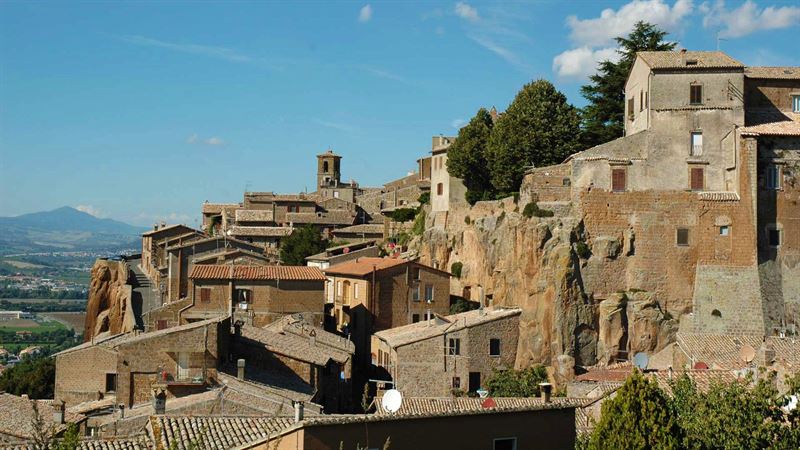
10. Orvieto – for an Umbrian marvel and one of Italy’s greatest cathedrals
Orvieto, to the south of Perugia, is the other great Umbrian gem and makes for a rewarding day trip. Allow for a ninety-minute car-ride (on the E45) or a two-hour bus journey. Orvieto, looming on a sheer ledge of lava-stone, is a brooding Etruscan presence hewn out of dark volcanic rock. The city’s precarious position and risk of crumbling puts it in the news from time to time – but its survival seems assured for now. The city is quintessential Umbria – moody, mystical, dramatic and stuffed with tempting inns. The fertile volcanic slopes are swathed in the vineyards that produce Orvieto’s famously crisp white wines. The story goes that Orvieto Cathedral was inspiration to Michelangelo in his creation of the Sistine Chapel in Rome. Even without that glory, the cathedral ranks as one of Italy’s greatest. If the treasures about ground were not temptation enough to visit, then consider the quirky Underground Orvieto tour. The city’s honeycomb of caves and tunnels represent a secret, second city that has been in use since Etruscan times.
Address: Tourist Office in Orvieto: Piazza Duomo 24, 05018 Orvieto
Web: www.orvietoviva.com -

Eating & Drinking
Although cooking in Perugia, the capital of Umbria, is resolutely regional, the high proportion of foreign students and visitors means that there is more than a nod to international tastes. The presence of so many students helps keep restaurant prices down and can make the mood more informal.
Along with Umbrian barbecued or roast meats, freshwater fish from nearby Lake Trasimeno may also be on the menu. The proximity of Norcia, famed for its Umbrian charcuterie, means that cold cuts are to the fore as antipasti, from mortadella to capocollo salami. As in Tuscany, Chianina cattle are prized so the succulent meat features strongly, as does wild boar, venison and spit-roasted porchetta.
Given that this is `the green heart of Italy,’ local cuisine makes full use of truffles, wild beet, wild asparagus and wild mushrooms, along with sought-after Umbrian olive oil, herbs and legumes. Spelt from Spoleto, lentils and black truffles from Norcia, beans from Foligno and saffron from Citta del Pieve find their way into savoury dishes. As in Tuscany, seasonality is key, with asparagus risotto signalling spring but truffled pasta more common in autumn. Try the speciality breads, a refreshing change from Tuscan blandness. Umbrian bread is far more varied and ranges from brustengo, oil-fried bread with bacon or rosemary, to pan caciato, made with pecorino cheese and walnuts. Umbrian wines are far less known than their Tuscan rivals but mostly deliver in terms of variety and value.
-
Al Mangiar Bene
Set just off bustling Corso Vannucci, this inviting, well-priced inn delivers on all fronts. With its vaulted brick ceilings and friendly mood, it feels like a genuine Slow Food citadel, which it is. The produce is sourced in Umbria or Tuscany, with the name of each cheese-maker and cattle-producer listed. From juicy steaks to herb tarts, truffled pasta and pizzas, the traditional menu is pretty faultless.
Address: Via della Luna 21, 06122 Perugia
Web: www.almangiarbene.it -
Antica Trattoria San Lorenzo
This romantic, upmarket restaurant offers more than candlelight and sweet nothings. On the menu is creative regional cuisine, from chestnut risotto to dishes made with Norcia black truffle, or a seafood tasting menu. Wine-pairing is available on request, with suggestions from the charming sommelier.
Address: Piazza Dante 19A, 06122 Perugia
Web: www.anticatrattoriasanlorenzo.com -
La Bottega del Vino
This cosy, quirky, welcoming wine bar does decent, good-value food, well-matched to regional and classic Italian wines. Typical dishes include home-made pasta, including with smoked duck. The liveliness and laidback mood compensate for service sometimes being a bit slapdash.
Address: Via del Sole 1, 06122 Perugia -
La Locanda del Cardinale (Assisi)
Decorated in what Italians call an elegant-rustic style, this vaulted, frescoed, fine-dining restaurant lives upto its billing and prices. The tasting menu might include such dishes as Jerusalem artichoke soup, mushroom risotto and pork belly. Glass floors reveal the remains of a Roman domus.
Address: Piazza del Vescovado 8, 06081 Assisi
Web: www.lalocandadelcardinale.com -
Ristorante Nicolao (Gubbio)
Set in a 17th-century monastery, the look is that classic Italian blend of heritage with a sophisticated sheen. mixing old stone, exposed beams, oak tables and contemporary art. This fine-dining spot serves beautifully presented seasonal cuisine, with both creative and Umbrian options.
Address: Park Hotel Ai Cappuccini, via Tifernate 06024 Gubbio
Web: www.parkhotelaicappuccini.it -
Alcatraz (Gubbio)
Put the world to rights in this alternative inn, more hippy than hipster. The inn is basic and bohemian in mood but serves traditional, organic food. Tuck into an antipasti buffet, tagliolini with asparagus, beetroot soup or beet-stuffed ravioli. Mains range from steaks to chicken and zucchini kebabs.
Address: Localita Santa Cristina, 06020 Gubbio
Web: www.alcatraz.it -
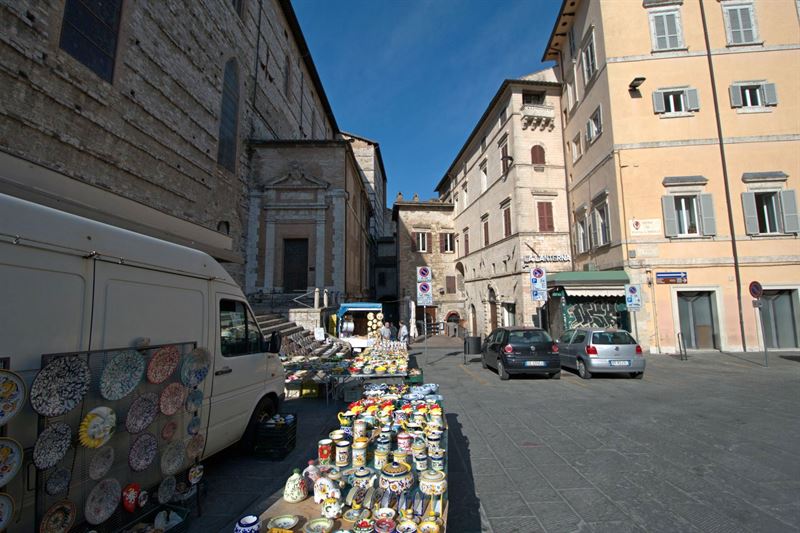
Shopping
Perugian chocolate is world-famous, particularly in the form of “Il Bacio Perugina,” the so-called “Perugia kiss.” The chocolates were invented in 1922 after a shortage of dark chocolate inspired Luisa Spagnoli to add hazelnuts to make her chocolate go further. The rest is history for the Perugina brand.
Eurochocolate, the ten-day October chocolate festival, also makes Perugia a delicious place for all chocolate-lovers.
Web: www.eurochocolate.com -
Chocolate factory feast with Perugina
Perugina is a world-famous brand so consider munching it in its homeland, visiting the chocolate factory or even indulging in a chocolate-making workshop. The factory might remind you of the film, Charlie and The Chocolate Factory. The tour ends in a bridge walk to the factory floor where white-coated workers (conceivably Oompa Loompas?) create Perugia’s top concoctions.
Chocolate tour: book ahead for the 90-minute guided tour (in Italian or English, times vary).
Chocolate-making experiences: book online
https://www.baciperugina.com/us/en/perugina-school-of-chocolate-514
Address: Via San Sisto 207, 06132 San Sisto, Perugia
Web: www.perugina.com -
Foodie treats and truffle-snuffling tour
Tartufi Bianconi specialise in tasty, home-made truffle products that can be booked in person or online. Typical pasta sauces are the white truffle sauce and the pesto with black truffle sauce. If pre-booked you can also take part in a truffle-hunting experience on their farm, accompanied by a truffle hound and its master. The experience can end with a simple truffle meal made in their farmhouse.
Address: Tartufi Bianconi, 06012 Citta di Castello, Perugia
Web: https://tartufibianconi.it/ -
Glassmaking experience
The art of glassmaking is alive and well in Perugia, in front of the Rocca Paolina fortress. Here you can visit the traditional Moretti-Caselli workshop-cum-museum where they have been painting glass since 1859. The star pieces are the portraits, which seem more like oil paintings but which exude a luminosity and brilliance that transcend a canvas.
Address: Studio Moretti-Caselli, via Fatebenefratelli, Perugia
Web: www.studiomoretticaselli.it -
Parking
Parking in Perugia can be a challenge. Like many Italian cities, Perugia operates a ZTL system, a strict Limited Traffic Zone scheme whereby non-residents are discouraged (or banned from) driving in the city centre, except at specific times or along specific routes. Even if Perugia’s system is currently being fine-tuned, with new regulations being brought in, it’s simplest not to try to drive in the “Centro Storico,” (“the Historic Centre”), which is mostly out of bounds to drivers who are non-residents.
ZTL: The Historic Centre ZTL is considered to be the area bounded by the following access roads: via Masi, via Campo Battaglia, via Battisti, via della Sposa, via Appia, and via San Sebastiano.
Car parks: Among the most central and convenient car parks are Piazza Partigiani and the Mercato Coperto. Charges are per hour but there’s also a free car park at Piazzale della Cupa.
Car parks listing: http://turismo.comune.perugia.it/pagine/parking
For more on the ZTL (Limited Traffic Zone) see:
(in English): http://turismo.comune.perugia.it/pagine/limited-traffic-zone
-

Getting around
Umbria has recovered as well as world-class art cities can ever do from the devastating 1997 earthquake that witnessed the collapse of part of the famed Basilica in Assisi. In 2016, the region was again struck by a severe earthquake but, with classic Italian resilience, virtually everything is now back to normal beyond the earthquake epicentre in Norcia, which is still bouncing back.
Getting there:
By air: Conveniently, reliable, direct buses run from Rome Fiumicino airport (via central Rome) to Perugia and Assisi (www.sulga.it). Perugia’s San Francesco d’Assisi airport is a handy entry point to Perugia and Umbria in general, and serves a number of low-cost European airlines.
By car: from the north, hop on the A1 motorway, leave at the Valdichiana exit, then take the lakeside route to Perugia, bordering Lake Trasimeno. From the south, take the A1 motorway, leaving at the Orte exit before following signs to Perugia.
By train: Perugia is on the Milan to Rome line. A fast, new train service now connects Milan and Perugia, with the journey time cut to three hours on a trial basis. On arrival, bear in mind that it’s a steep climb from Perugia's train station so take the bus to Piazza Italia.








